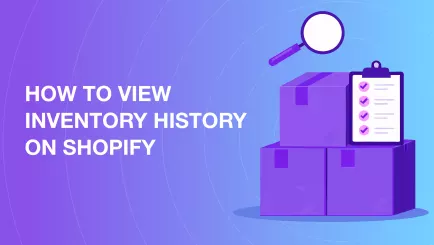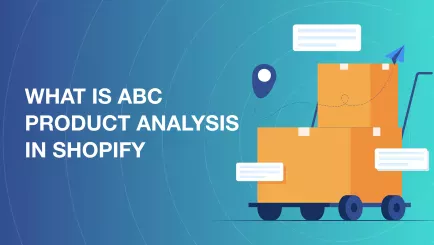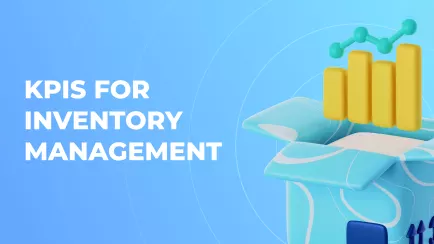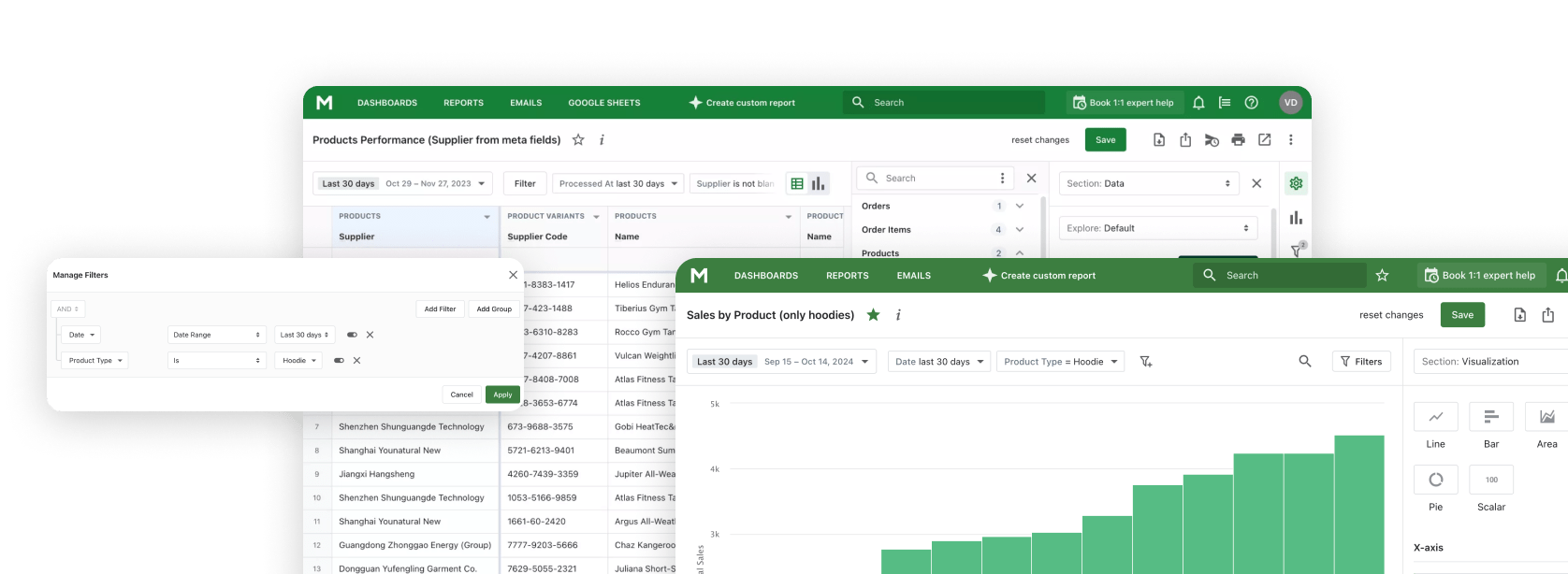E-commerce is growing every year, and it seems that this trend is unstoppable. Customers are gradually shifting from offline to online purchases, and this trend is accelerating every day. Every new study confirms the growth of the e-commerce industry. This trend even applies to relatively conservative sectors.
In certain cases, there may be exceptions, but overall, as a specific e-commerce business grows, so does its complexity. The workforce expands, new positions are created, additional sales channels are added, new advertising platforms, affiliates, partners, etc.
Simultaneously, the number of sources of available information and the volume of the data itself are increasing. Every order, every visit, every click, every ad impression – it's all information. Is this information valuable? If interpreted correctly, yes. Skilfully correlating information from various sources can lead to unprecedented results. Moreover, new professions emerged solely focused on working with data: Data Analysts, Data Scientists, Data Engineers, Data Architects, Web Data Analysts, and Data Security Specialists.
Another issue is that as the business grows, more and more links separate people from each other. It becomes increasingly challenging to control operational metrics that directly impact key performance indicators.
The business expands, and new workgroups and departments are formed. Everyone needs data. Different types of data. Sales figures, advertising metrics, customer engagement metrics—for analysis, forecasts, planning, etc. Everyone outputs their figures, which serve as indicators of their effectiveness. But how do you access the data if it's in different sources and formats?
Additionally, there is the question of choosing a centralized system for analysis and reporting, along with a centralized data repository.
Without a centralized repository: Loss of opportunities
For small businesses, the absence of a centralized data repository is not a significant issue. Firstly, the amount of data is not large. Secondly, the number of data sources rarely exceeds 3-5. Therefore, the data can always be collected into a single Excel table or uploaded a few CSV files into analytical systems. Yes, it requires a lot of manual work, but it's not overly complicated.
However, as the transformation to an in-house e-commerce business reaches mid-size, disparities begin to emerge. Different departments see different input data and fail to see the impact of their actions on the overall outcome. More people in the organization start making decisions using a limited amount of information, leading to a loss of unity and a decrease in efficiency.
The result is a slowdown in the growth of key e-commerce business metrics.
Another critical point is the potential loss of new growth drivers:
- A: They may simply go unnoticed;
- B: Incorrectly assess them in a limited data environment and make the wrong decision.
ETL in the context of e-commerce
ETL is the process of collecting, transforming, and storing data in a centralized repository. As a process, it emerged and was formalized quite some time ago, back in the 1970s. However, it gained widespread use only with the growth of the number of web services, meaning when the sources of available data became diverse and branched. Currently, there are dozens of both free and paid services that can fully cover the transfer of various data to a unified repository. More details can be found here: Consolidate All Data in One Place: Power of ETL for Shopify Stores
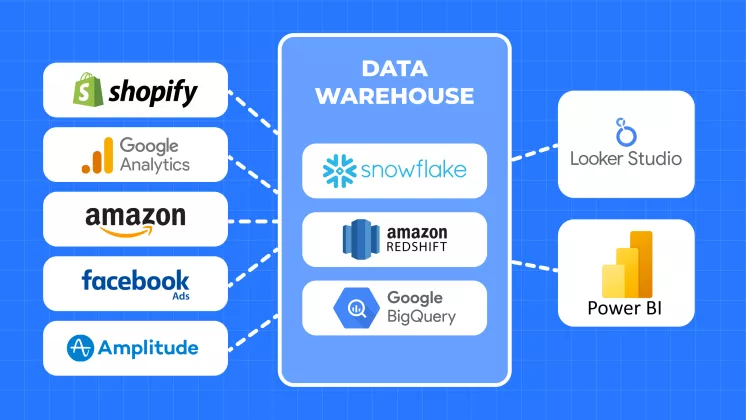
In the e-commerce context, ETL performs the function of collecting data from dozens of sources into a single database. Thus, you obtain a unified repository where all your data is stored. This, in turn, standardizes access to any data and significantly facilitates providing access to the necessary information.
As a result, all employees, contractors, or other individuals or companies gain access to the data they need for their effective activities.
For most e-commerce databases, the following information will be included:
- Self-store data or backend data (orders, products, inventory, transactions, taxes);
- Analytics data - visits, impressions, CTR from services like Google Analytics, Search Console, Mixpanel/Amplitude;
- Ad platforms - clicks, impressions, cost, performance from services like Google Ads, FB, Criteo, and dozens of others;
- Marketing - Mailchimp, Sendgrid, Instagram, Hubspot, and others;
- CRM data;
- Internal systems and reporting (budgets, plans, goals, suppliers, and so on)
Data Warehouse for E-commerce
The warehouse, in most cases, is a cloud database such as Google BigQuery, Amazon Redshift, or Snowflake. A cloud warehouse has several key advantages, including:
- Ease of connection;
- Security;
- Availability (uptime rarely less than 99.9%);
- Data retrieval speed;
- Scalability.
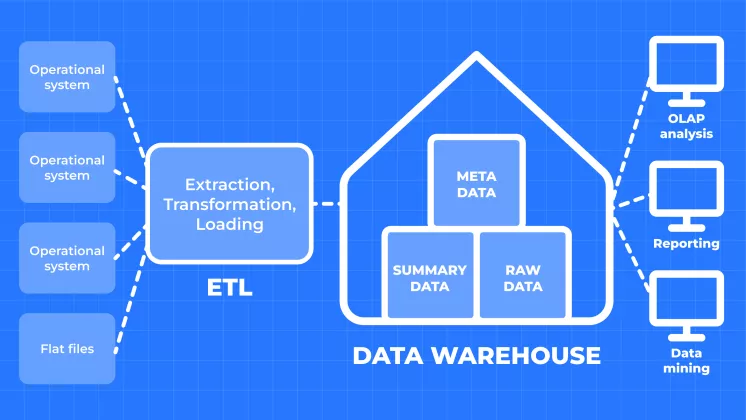
It's also possible to deploy a local data warehouse based on PostgreSQL or Microsoft SQL Server. However, this is generally a less reliable and cost-effective solution.
It's worth noting that even though you have a single data warehouse, data can be easily distributed into access groups, known as Data Marts. This way, various groups and departments will have access only to the data necessary for the effective completion of their tasks.
Once the data is obtained, the next step is analysis, report generation, and metric output. At this stage, the limitations are only in the imagination of those working with data and reporting systems, utilizing common tools like PowerBI or Google Looker Studio.
Why ETL?
ETL is essentially a process. It is necessary for creating a unified information (data) environment and maintaining its relevance. However, it is one of the few key processes. ETL doesn't just copy data from the source to the warehouse; it also properly structures, cleans and prepares it.
The ETL process plays a leading role in obtaining and preparing data for analytics, reporting, or business analysis.
Each department of the company can benefit from or even should use, the data for both planning and assessing effectiveness.
Explore related reports
What to Expect from ETL Implementation
It's not enough to implement the ETL process and create a unified data warehouse. You need the ability and skills to extract useful information from the warehouse, and numerous analytics systems can be handy, typical ones like Power BI and Looker Studio, and more specialized ones like Exploratory.
You can gradually implement and use various reports depending on tasks and goals:
- 360-degree overview of e-commerce marketing effectiveness;
- Funnel analytics and conversion improvement at each stage;
- Customer profiling and increasing LTV;
- Development of new products or services;
- Discounts and promotions backed by historical data;
- Evaluation and improvement of customer service;
- Effective inventory management;
- Improvement of ROI
For each of these tasks, specialized Shopify Reports can be created - aimed at a narrow circle of specialists, summary reports for middle-level managers, and high-level reports or dashboards for C-level executives.
Importantly, all these reports or Shopify Dashboards are created from the same data but with different levels of granularity, ensuring accuracy across all levels.
And what about AI?
Today's trend is also the implementation of AI technologies in various aspects of business, from content creation to customer segmentation. Even here, a unified data warehouse can be beneficial.
Just imagine that all customer communication is stored in the database. Fairly simple AI models can automatically analyze the content and:
- Classify requests into groups;
- Determine sentiment (customer satisfaction);
- Consolidate similar requests and summarize them into one or two sentences;
- Identify products or groups with the highest number of inquiries.
Starting Your Own Centralized Data Warehouse
The first stage of implementing anything always begins with an analysis of what we currently have and what we want to achieve in the future. A clear understanding of needs (including future perspectives) is a key factor influencing goal attainment during the implementation process.
- First and foremost, it's crucial to clearly define the reporting or analysis needs and their requirements.
- Based on this, you can identify a set of data needed to build these reports.
- Following the data, there come the data sources. Do you have access to all the necessary data sources?
Next are more technical steps, but they are equally essential:
- Define the structure of existing data;
- Determine the relevance and quality of the data;
- Identify the desired data structure and, based on that, create a list of transformations to be applied to the data;
- Choose ETL (Extract, Transform, Load) tools;
- Select a data warehouse;
- Implementation, testing, and adjustments.
As evident, some steps are not quick, but the goal is not to do everything at once. Initially, it's necessary to build a stable framework and launch the entire interaction chain. Then, as the need arises for new data, add new ETL processes and expand the data warehouse accordingly.
ETL and Data Warehouse for E-commerce
If you are still uncertain about whether you need to implement a centralized data warehouse and what value it can add to your business, we invite you to book a free online consultation with our technical specialist.

